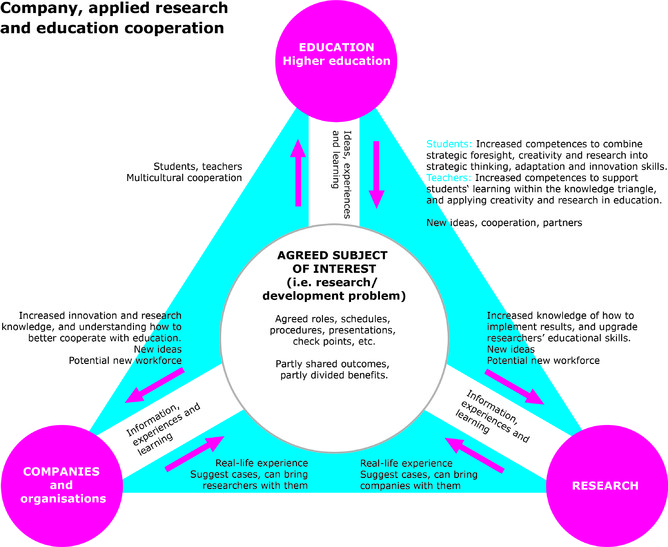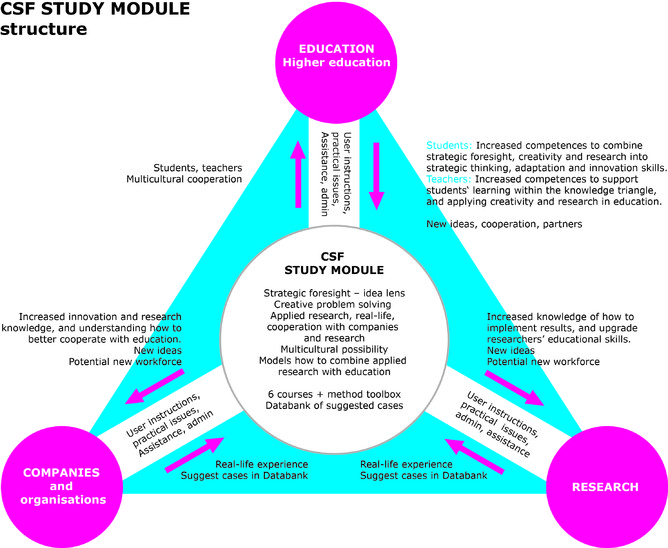Models of applying enterprises and research with education
Two of the most discussed topics in today's educational world are the future skills required for tomorrow's society and cooperation between education, research and the business world (enterprises, organisations). The European Union uses the concept of the Knowledge Triangle to highlight this process. However, the knowledge triangle includes a stronger integration of innovation.
The worlds of enterprises and business life (incl. organisations), education and research share a number of touch points. For instance, in many countries practical training is a mandatory part of professional education, and apprenticeship training has been a common practise throughout centuries. Correspondingly, professors are often also researchers and thus function as lecturers as well. A limited number of students also work as assistants in research, especially during the more advanced phases of their studies.
The CSF project (Creative Strategic Foresight) aims to provide alternatives to this combination of issues, by delivering a full study module which combines higher education, research and the world of enterprises. This is done via the CSF Study Module, which combines strategy with creativity and foresight.
Various reports list the annual competitiveness and innovation scores on a global level. According to these reports, Europe maintains a high status in competitiveness and innovation. For example in 2011, 7 out of 10 of the most competitive economies were European.
Europe has long relied on its centuries-long scientific and academic traditions. However, in today's society this is no longer enough, as theoretical knowledge does not create competitive bases alone. It is increasingly important to integrate real-life experiences also in higher education. Theory serves as background which can be applied in practice in creative and productive, thus innovative ways.
The worlds of enterprises and business life (incl. organisations), education and research share a number of touch points. For instance, in many countries practical training is a mandatory part of professional education, and apprenticeship training has been a common practise throughout centuries. Correspondingly, professors are often also researchers and thus function as lecturers as well. A limited number of students also work as assistants in research, especially during the more advanced phases of their studies.
However, this is generally rather limited, or oriented towards vocational training. Let alone applying the combination of education + research + the world of enterprises. One could name many reasons. We could also simply presume that so far there have been limited instances, or depth of application of this three-dimensional model, or that many do not recognize the value of applying it. It may also be that lack of time, separate courses, etc., create a space which hinders the full application of all the three dimensions contemporarily.
The CSF project (Creative Strategic Foresight) aims to provide alternatives to this combination of issues, by delivering a full study module which combines higher education, research and the world of enterprises. This is done via the CSF Study Module, which combines strategy with creativity and foresight.
The core process and principle are simple: bringing the three parties together to work on an agreed issue which comes from a company, is the subject of research and students participate in the research process. This is demonstrated in the illustration below.

The illustration above describes the model which has been used in the CSF study module:
The CSF Study Module in based on a similar structure:
- The subject case comes from a company or research (institution). If it is company-based (company-specific issue, can be development-based), an applied research aspect is added to it. If it is applied research-based (a more general research problem), often companies are added as case companies and research subjects.
- The research-development issue is defined, and processes, work roles and tasks are agreed. Students can be included in defining the research issue or invited to work on specific issues. The issues students work on can cover a larger/whole issue, or they can be part of a bigger system. For example, one student can focus on generating concepts for one of the companies participating in a research project.
- Common checkpoints and meetings assist in defining the process and deciding on the next steps to be taken.
- Normally the final results are processed together with all three parties present - including the teachers and/ or professors.
The CSF Study Module in based on a similar structure:

As the learning of different issues supporting learning creative strategic foresight, the CSF courses are placed in the centre where education, enterprises and research meet. Each course of the CSF Study Module operates on this three-dimensional model of cooperation on a smaller scale, and the final tasks combine all the learnt (note, bigger company or research case).
Examples of existing models and case examples of cooperation between education, research and enterprises
The CSF project consortium identified a number of existing practices of cooperation between education, research and enterprises, and experiences related to them. The project organisations currently practice the following:
Full implementation of the three dimensions aiming at concrete outcomes:
Case a)
Case d)
Students participate in the projects of applied research. Companies participate in the research projects. The process is run by professional researchers and other professionals who also tutor and guide students' work. Teachers have a very small role - often none. Students can be working on one of the companies or more, or on some cross-cutting topic involving more companies. The research project creates real outcomes and companies get real results.
Full learning by doing and problem-based learning for students. No separate educational guidance, except tutoring and guidance by professionals. Concrete professional projects and outcomes.
Case b)
A separate course organised for bringing together SMEs and students. The case example is DesignCamp (link of DC 2012) in which a small number of multidisciplinary students and SMEs meet and work on the SMEs' issues. The outcomes can be general or finalised (applied) research and development-based concepts. The process is guided and tutored by professionals. During DesignCamp, students are provided lectures on different subjects by researchers and design professionals. The professionals also select and interview the SMEs, make an issue analysis for them, and make the selection of suitable students.
Two essential issues are: students are multidisciplinary - during DesignCamp they learn design thinking and design methods (including design research) which they need to apply on the company cases. Secondly, the participating SMEs have to be small, e.g. starting companies who have not yet used design. Through DesignCamp they have a possibility to safely try using design and design-based research, and discover its outcomes. The SMEs also obtain research results on their case.
The outcomes have an educational purpose for both the target groups.
Case c)
Students participate in product development courses (for technical students, not design). The same courses include lessons and guidance by industrial designers and researchers (also industrial design researchers). The development topics and cases are provided by the companies.
The outcomes have an educational purpose.
Case d)
Working on company cases in different courses with mainly intercultural student teams.
The outcomes have an educational purpose.
Full implementation of the three dimensions aiming at concrete outcomes ? companies as students:
Case e)
Students in the Master programmes in the University of Applied Sciences work in companies and organisations. In their assignments they have the objective to develop their own organisations and companies.
The outcomes have an educational purpose, but they are directly applied to the students' own work contexts.
Case f)
Training programmes, models and courses directly for companies.
The outcomes have an educational purpose.
Existing, but not formalised cooperation between the three dimensions
Case g)
Activity not formalised, although partnership agreements exist with companies where students are located for partnership. A large network of companies is used for this.
The outcomes have an educational purpose.
No cooperation or lacking tangible outcomes for companies
Case h/i)
No activity between the three. It has been mentioned that companies are tired of being researched only. They want concrete, tangible outcomes and benefits from the cooperation projects.


